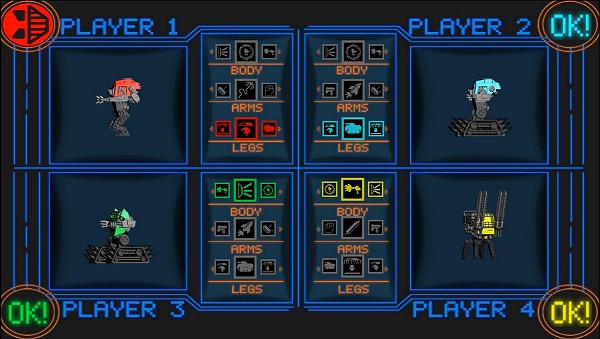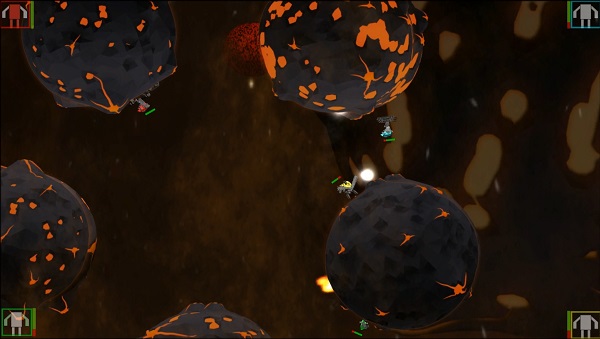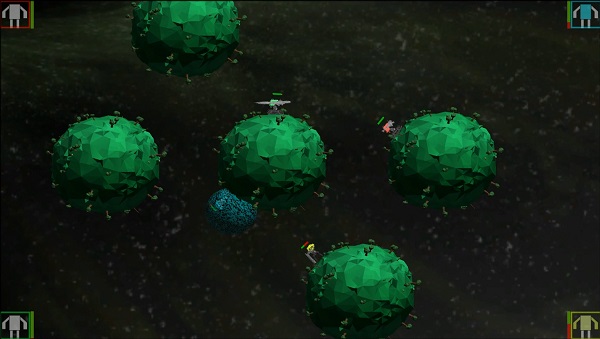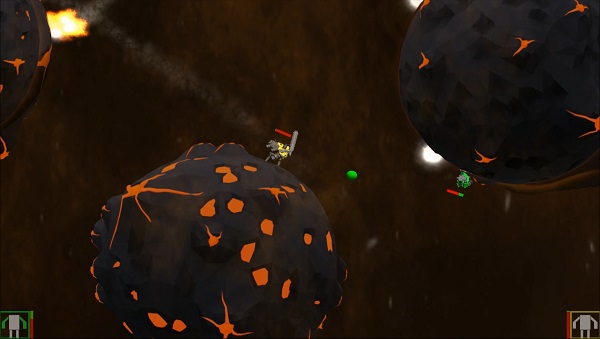
Project Title: Robo Drop
Development: C# / Unity
My Role: Lead / Gameplay / Physics Programmer
Designers: Jak Tiano, Ian Sartwell
Artists: Ryan Leslie, Shain Strother
Programmers: Evan Schipellite, Timothy House


Robo Drop is a multiplayer LAN game directed towards the console market. The game allows for 2 to 4 players to build unique robots and proceed engaging in fast-paced combat surrounding several different planet-based levels. All player robots share a universal navigation and jumping system that allows them to maneuver around planets and hop between gravitational fields. However, at the start of each round players can choose specific parts for their torso, arms, and legs to provide them with a combination of abilities for each match. Each round encourages players to quickly chain abilities to maximize damage, leaving the last surviving robot as the winner of the round.
Robo Drop was created over the course of about 11 to 12 weeks. The initial team included Jak Tiano, Ryan Leslie, and myself. From the start of the project, we quickly went about brainstorming ideas concerning the nature of the overall gameplay and combat system. This included the creation of about 12 to 15 robot pieces that would eventually be scoped down to 3 torso parts, 6 arm parts, and 3 leg parts. Our original game concept included a phase where players would compete against each other to collect the available parts, thus limiting players to their gathered parts and encouraging them to create the best robot from a limited supply. However, due to scope and complexity relating to the process of balancing the game in a multiplayer environment, this was let go in favor of further concentration on the balancing between ranged and melee weapon types.
Once further members merged onto the project, I further took responsibility in terms of organizing tasks for each sprint, continuing to develop and polish various parts mechanics as they were added into the game. Tim House expressed interest in working within the menu and UI space, and therefore he became the UI Programmer, focusing on building systems for visual feedback, match information, and inventory / level selection screens. On the other hand, I worked further within the gameplay environment and desired physics responses, creating each individual weapon mechanic and testing how it functioned within the gravitational environment.
As I continued to explore each weapon mechanic, and as I further became used to the types of physics responses were desired, I discovered that a lot of functionality that would begin as complex and challenging eventually could be recycled and brought into different part mechanics. For instance, after spending some time working out the foundation for the shield mechanic, which would allow the player to reflect any projectile in an indicated direction, this feature eventually was adapted for other mechanics as well. The reflection aspect not only was utilized for the torso energy burst, but it also served to allow for the grapple mechanic to eventually conduct the reverse process and bring objects closer to the player.


By breaking down each group of parts into individual sprints, I was able to quickly create prototype mechanics that could be utilized to test and verify the applicability of each desired mechanic. As a result, many pieces went through drastic changes. This was mainly a matter of seeking to keep in mind the necessity to balance parts. As the inventory became more populated, it became increasingly obvious that ranged weapons such as the machine gun and rocket launcher remained dominant due to the fact that the player could avoid the direct fight and hinder enemies from distant planets. While still possible, if enemies don't confront ranged players, this situation was largely adjusted by providing melee users with a little more health and speed, while also requiring ranged users to exhibit precision with their attacks. Individual machine gun pellets and explosions from rockets deal reduced damage, while full bursts and direct hits deal more, therefore encouraging ranged users to stay close enough to properly aim their abilities.
Throughout the early phases of the project, the gravity system was refactored a bit in order to find the best medium for navigation and combat. While original movement felt smooth, it limited interaction with physics from enemies, and therefore needed to be improved to better convey the dynamic nature of the combat system. While grounded, players now find that their reaction to forces is reduced as a result of the stronger gravitational pull toward the center of the planet. While still undergoing some amount of force from enemies, this prevents players from constantly being thrown off planets without enough concentrated burst from an enemy. Players within the air will find that projectile and weapon forces have a much stronger impact, therefore leaving them vulnerable to knock-backs that take advantage of sending them into orbit or entirely off planets. The purpose of these changes was mainly create a combat system that would encourage jumping as a dodge and maneuver mechanic, while also giving players incentive to ground themselves to effectively aim attacks.